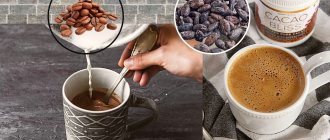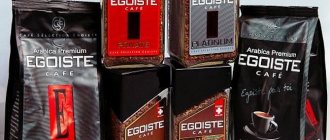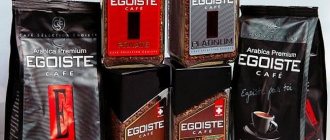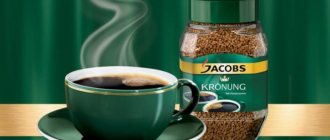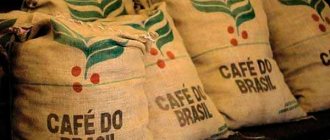Brand history
In 1994, three Russian businessmen - Alexander Evnevich, Sergey Kasyanenko and Dmitry Varvarin - created. Initially, the company focused on the supply of Ceylon tea. But soon the entrepreneurs decided to develop an as yet unoccupied market segment. In the 90s, the country experienced a shortage of inexpensive but high-quality coffee. It was decided to master the direction, for which a new brand was registered - “Jockey”.
Initially, the company was engaged only in sales - raw materials were processed and packaged abroad. But by 2000, the first roasting workshop appeared and soon production started working:
- in 2001, the production of whole bean and ground coffee in vacuum bags was launched;
- in 2003, packages with aroma filters appeared;
- in 2004, a line of soluble varieties was launched;
- in 2022, a line for the production of freeze-dried and granulated coffee was opened in Russia.
Today, “Jockey” is a full-cycle coffee production: from the entry of green beans into the workshop to the release of packaged products. In Russia, Orimi Trade owns two factories - in St. Petersburg and in the Leningrad region.
Attention! The company has come a long way in 20 years. The Jockey brand has won many prestigious awards and received the Product of the Year award several times. In 2014, the company received the St. Petersburg Mark quality certificate.
Jockey products are sold not only in Russia, but also in the CIS countries and other countries. The brand has gained extraordinary popularity in Germany. Since 2016, Orimi Trade Ukraine has been operating as a coffee roasting subsidiary.
How to prepare ground coffee in Turkish?
- Pour the powder into a warm cezve. Its quantity should be as desired, but the average proportions are 1-2 teaspoons per 100 ml of water. Next, warm up the coffee a little with shaking movements, so it will release the aroma more easily. The whole process should take place over low heat.
- At this stage, you can add sugar or spices as desired. Some people add grains of salt to enhance the flavor.
- Then pour water to the narrowest part of the Turk and stir the drink with a spoon. There are special long devices for this.
- We wait until foam begins to appear on the surface. We do not allow the drink to boil. As soon as the “cap” on the coffee reaches the edge of the Turk, remove the vessel from the heat.
- To keep the grounds at the bottom of the cezve, you can hit it on the table several times. And then pour the drink into cups.
The main thing in this process is not to let the liquid boil, because in this case the coffee will lose its signature aroma and the taste will be less intense. Regarding the amount of powder, it is worth saying that too much can give an unpleasant bitter taste.
Composition of coffee "Jockey"
The brand does not work with premium varieties, focusing on high-quality coffee in the budget segment. Under the Jockey brand, mainly equal blends of Arabica and Robusta are sold. Raw materials are purchased from all coffee production regions: Africa, South and Central America and Asia.
Blends are characterized by a slight bitterness inherent in robusta. In addition, this type contains more caffeine than Arabica, which is why Jockey coffee turns out to be so invigorating. Each variety is roasted individually and then blended by master blenders to produce a drink that meets the highest quality standards.
Some types of Jockey coffee are made from 100% Arabica coffee. Depending on the variety, raw materials from only one region are used or blends are created from grains grown on plantations in several countries. This allows for new flavors to be developed, as coffee beans grown in different areas have their own characteristics. Thus, Colombian beans are characterized by citrus notes, Ethiopian beans are dominated by floral tones, and Asian beans are distinguished by woody and nutty tones.
Raw materials and creation
The holding works with Arabica and Robusta, purchasing unroasted beans from Central and South America, Africa, Asia and Oceania, in other words, all regions where coffee grows. Each variety is roasted separately to reveal its best properties, and then technologists combine them into blends. Hundreds of kilograms of beans are roasted once a day, and they are then packed in a vacuum or in packs with a degasser.
The entire process is 100% automated. The operator sets the required values, and then the machines do all the work, checking the processing time and packaging down to the second. The ground is ground depending on the variety and manufacturing features. The plant has passed European certification, therefore it offers customers only high-quality products.
Coffee making technology
In the production of Jockey coffee, different degrees of roasting are used - this allows you to obtain different flavors from the same raw materials:
- light retains rich aromatics;
- medium helps to obtain a harmonious combination of organoleptic characteristics;
- The dark one reveals the taste most clearly and allows you to get rid of the inherent sourness of Arabica.
The entire technological process is fully automated. The share of manual labor in production does not exceed 3%.
Attention! For packaging of finished products, only chemically inert materials are used: glass and tin cans or vacuum bags. This avoids the coffee from absorbing foreign odors and tastes.
Elite grain varieties Jardin
All Arabica varieties that go into the production of Jardin coffee grow on the fertile volcanic soils of Ethiopia, Kenya, Guatemala, Colombia, the islands of Java and Sumatra. Other varieties grow in this area, but lower in the mountains or even on the plains.
Highland Arabica is considered the most elite, but it is very expensive and is produced in limited quantities. Jardin producers purchase raw materials that grow at medium altitudes. It differs in that the berries ripen faster and have less density.
Ethiopian coffee
One type of ground coffee is Jardine - Ethiopia Sidamo. Designed as a single variety for making espresso, it comes in a whole grain version. The taste is slightly sour and has fruity notes. This is not the strongest coffee - its coefficient on the Jardin scale is 3. The roast is dark.
Guatemala
The beans are medium roasted, but the drink is strong - on a scale of 4. Guatemala Cloud Forest is suitable for any brewing method - Turkish, coffee makers, French press. Connoisseurs detect familiar notes of black currant in the drink. Grown in low oxygen conditions, the grains gain density - they are the hardest of the entire Jardin product line.
Colombia
For those who are wondering which Jardine coffee to buy with chocolate flavor, this is Colombia Supreme. The taste of the beans is bitter, but it leaves an aftertaste of cocoa. The aroma is pronounced. Medium roast. Monosort is suitable for any device - drip coffee maker or coffee machine.
Colombia Medellin contains grains from the country's region of the same name. This is the strongest drink with a factor of 5. The taste combines chocolate and fruit.
Sumatra
Sumatra Mandhelling is a particularly strong, intense flavour. The aftertaste of tobacco and oriental spices makes it a drink for everyone. On the scale, Jardin has the most intense aroma and taste.
Kenya Kilimanjaro
Arabica, native to Kenya, has citrusy and floral notes. This is a mild variety with a light roast. Suitable for evening use as it does not affect the quality of sleep.
Types of coffee "Jockey"
The variety of assortment produced under the brand allows everyone to choose a drink to their taste. Today the company produces whole bean, ground and instant coffee. The following varieties of Jockey coffee are the most popular among whole bean coffee:
- “Classic” is a blend of Arabica beans from India and Brazil. The drink has a soft taste with a slight hint of vanilla and almost imperceptible sourness.
- “Traditional” - Arabica beans grown in Africa and Central America are used in its production. The drink has a rich taste and bright invigorating aroma.
- Caffe Italiano is a blend of Arabica beans from the African continent, India and Brazil. Dark roasting makes the drink rich and bright, fully corresponding to its name - this coffee is served in Roman, Milanese and Venetian coffee shops.
- “Oriental style” - beans from Brazil are added to Arabica beans grown in India and Ethiopia. The rich taste inherent in dark roasting will be appreciated by those who like to brew coffee in a cezve.
These same varieties are also available in crushed form. The “Jockey” grinding is “Traditional”, “Classic” and Caffe Italiano – medium, most suitable for preparing the drink in a French press or carob-type coffee machine. “Oriental coffee” has the finest grind required for brewing in a cezve.
“Jockey for Turks” is also produced - this is dark roasted ground coffee from Vietnamese, Mexican and Cameroonian Arabica beans. It has a light, crisp flavor that comes from being lightly roasted. Finely ground powder is ideal for boiling in a cezve or brewing in a cup.
Flavored coffee varieties quickly gained popularity:
- "Bavarian chocolate";
- "Irish Cream"
- "Hazelnut";
- "Red Orange"
The following types of instant coffee “Jockey” are produced:
- "Triumph" - sublimated;
- “Favorit” - granular;
- "Champion" - powder.
3-in-1 bags are also in demand. Three varieties are produced under the brand: Classic, Caffe Forte and Latte Art.
What are coffee producers hiding?
Stanislav Urzhumtsev , one of two experts in Russia who have the prestigious NAMA coffee industry certificate, told Rosbalt what they won’t tell you in any coffee shop, as well as how to choose the perfect coffee
— Is Arabica really the best type of coffee?
Everything we buy in the store is a mixture of two varieties - Arabica and Robusta. One hundred percent blends of Arabica or Robusta, even if their content is indicated on the pack, are not found. In general, there are more than 20 types of coffee. But only two are mass produced - Arabica and Robusta. Robusta is a species that is more unpretentious to weather conditions and produces the largest harvest. It has not very beautiful beans, but it is very strong - with a high caffeine content. Arabica is more aromatic, but since it is sensitive to weather conditions, it has a smaller yield and is susceptible to disease, which means it is more expensive. As a rule, all manufacturers allow some percentage of Robusta content in 100% Arabica blends.
— Isn’t the presence of Robusta in “100% Arabica” blends a deception of consumers?
- No. This is allowed by the standards. The presence of robusta does not affect the taste, since the percentage of its content in mixtures is negligible. If there are one or two robusta trees growing on a plantation, this is not noticeable. The choice of coffee is a matter of personal taste. For example, it cannot be argued that a person who is presented with two cups of coffee, one of which contains the most expensive Blue Mountain variety, selling from $100 per kilogram, and the other - Brazilian Arabica at $5 per kilogram, will prefer the coffee from the first cup .
— Why is price not an indicator of taste? Why then is Blue Mountain coffee so expensive?
Experts rate Blue Mountain as a very good and tasty variety. Its price depends on the fact that it is collected very little - only 900 tons per year worldwide. And, for example, Arabica production volumes amount to millions of tons. An even more expensive variety than Blue Mountain is Kopi Luwak. Its price - about $200 per kilogram - is due to the fact that the cute little animals of the musanga simply cannot produce more. They pass the coffee beans through their esophagus and thus promote the fermentation of the coffee. The result is a dense, rich, soft variety.
— Why does the taste of coffee, for example, in Italy differ so much from the coffee in Moscow cafes?
— Because manufacturers adapt to the regional preferences of consumers. First of all, the taste is affected by how the crop is harvested. For example, in some countries, coffee is fermented - put in barrels and filled with water. It is fermented for several days, then dried and sent to consumers. This is what they do, for example, in Colombia. To an uninformed person, this coffee may taste more sour.
From the plantation, the coffee enters the factory and then the most secret part of the technology occurs - mixing and roasting. When the average person talks about the strength of coffee, they often mean its bitterness, which is achieved during the roasting process. Although the pleasant bitterness of coffee does not say anything about the caffeine content or its quality, but only indicates a particular degree of roasting. Italian and French roasting is the darkest and highest degree. In these countries, coffee is roasted very hot.
This is sometimes done in order to hide the true composition of the coffee. So that you can, for example, put 80% cheap Robusta and 20% Arabica. In this way, some manufacturers disguise coffee for sale. A high degree of roasting is considered traditional for making espresso. Therefore, coffee in Italy or France seems stronger to ordinary people. By the way, coffee of the same brand may taste different not only in different countries, but also in cities of the same country.
- Why?
— For the manufacturer, the most important thing is to maintain a consistent taste from batch to batch. It is important that the buyer, when purchasing a coffee blend of a certain brand, receives a consistently identical taste in each pack. A whole cohort of specialists is working on this. One brand of coffee can include up to fifty varieties of coffee from different countries. But on the other hand, if you buy the same brand of coffee in Paris, St. Petersburg and New York, it will taste slightly different. When creating certain varieties, most manufacturers even take into account the taste preferences of individual cities - for example, Moscow or St. Petersburg. Only Italian producers do not engage in such regional packaging. Before launching any brand of coffee, a group of specialists is sent to the region to study preferences, see what kind of coffee is served and how it is served in restaurants and cafes, and what consumers prefer.
— What is the taste like, made for Russia?
— A country that grew up on instant coffee and coffee heavily diluted and roasted to achieve the illusion of strength is very distrustful of any other type of coffee except Arabica. It is believed that if the package says “100 percent Arabica,” then it is good coffee. The Russian consumer is obsessed with the Arabica brand. And this type of coffee can be very different. For example, Blue Mountain and Arabica from Brazil.
— So it turns out that we drink the coffee that experts believe we love?
- Yes. And there is no need to be afraid of this. The basic rule of coffee lovers: the best coffee is the coffee you like. For example, Pauling brand espresso is so popular that it even began to be sold at McDonald’s because it was made and “customized” for Russia.
— What should you pay attention to when choosing coffee?
— You can only find the perfect coffee for yourself through trial and error. It is also worth giving preference to large manufacturers who maintain a “single taste level”. If you like coffee with sourness, then pay attention to Colombian Arabica. If you value aroma more, choose brands of less heavily roasted coffee, correlating it with the country of origin.
— And if I want very strong coffee, how can I choose the variety with the highest caffeine content?
— It is very difficult to determine the caffeine content of coffee by taste. The higher the roast level, the more bitter the coffee becomes and is perceived as stronger. The entire coffee flavoring industry is built on the misconception that bitterness equals strength. By the way, it is a mistake to think that espresso is stronger coffee. Espresso is prepared very quickly and does not have time to fully release the caffeine it contains. Coffee prepared in a French press, as well as filtered and brewed in a Turk, contains more caffeine.
- How much more?
It all depends on the cooking time. If you fill it with cold water and use a large coffee pot, the amount of caffeine in your coffee will increase significantly.
— Is the price of coffee a guarantee of its quality?
No. This is a derivative of the high cost of advertising and marketing policies. The retail price of good coffee starts somewhere around $10 per kilogram.
— So, a pack of coffee should cost less than 100 rubles?
Yes.
— But you rarely find such cheap coffee in stores?
Why? For example, coffee under the brand name “Jockey”. Good Dutch technology can be felt here. This coffee is distinguished among budget brands by the identity of the blend and excellent flavor tones. This is also a mixture of different types of coffee, but very high quality. And an additional bonus is that it is not much different from many Italian coffees that cost more than two hundred rubles per pack.
— How to choose good quality budget coffee?
I would note retail chains that produce coffee varieties under their own brands. For example, I personally like coffee from Ethiopia, sold under one of its own brands in the Auchan retail chain. It has subtle chocolate notes and a rich aftertaste. But that's my personal taste. A lot depends on how you like to make coffee. The best coffee does not mean the most expensive, but the most delicious for you.
Therefore, you need to give preference to brands that you know. And try something new. If you liked a certain taste in a cafe, don’t hesitate to ask for the variety and brand. Among the inexpensive but high-quality ones, I would highlight all the brands of the Pauling and Jacobs companies.
— What can you say about “Lavazza”?
This is a world famous coffee brand. But when buying this variety, remember what I said about Italian roasting. It seems to me that this brand of coffee is too overrated in Russia. In Europe it sells for 2 euros per pack, but here it is considered premium. Although Lavazza coffee (in comparison with other Italian producers) is a very good level of coffee.
— How to choose the perfect coffee?
Professional secret: you need to drink a cup of black coffee, and after half an hour evaluate its aftertaste. If you find it pleasant, then the coffee was good. And only by assessing and describing your feelings will you give an accurate assessment of the coffee. If you are not familiar with the brands of large manufacturers, think about how you will prepare coffee. Will you be making espresso, brewing it in a Turkish coffee pot, just brewing it in a cup, or do you need it to make filter coffee?
— Is it worth buying coffee beans?
If you grind your coffee at home, it will, of course, taste better - because of the freshness of the grind. But coffee beans are more expensive than coffee of the same brand, but ground. Because, for example, the manufacturer will not put ugly-looking grains into the grain mixture. You need to grind the beans depending on the method of preparing coffee. For Turks, the smallest fractions are best suited (grinding takes longer). For espresso - a little larger.
— And if I want to make stronger coffee at home, can I grind the beans for Turkish coffee, but put the mixture in the espresso machine?
Most likely, nothing good will come of this. There is a high probability that water will not pass through this dense layer of coffee. Industrial coffee grinding is ideal for espresso machines, and vacuum packaging guarantees coffee freshness for several years. By the way, it is best to store an open pack of coffee in the refrigerator, in a closed container.
— It is believed that the fashion for drinking coffee came to Europe from Vienna, where they served coffee with milk. What can you say about Austrian coffee producers?
Coffee came to Europe through Holland. So the true legislators of coffee are the Dutch. It was they who spread coffee throughout Europe, including Vienna. Milk is added to Viennese coffee. And if you add milk to coffee, for example, to make cappuccino or Viennese melange, then the taste of the drink will change greatly, and it will be very difficult to judge the taste of the coffee mixture itself. Relatively speaking, the perfect cappuccino can be made using the cheapest type of coffee.
— How to achieve tasty foam?
In the professional coffee world, the presence of foam is a bad sign. But it is believed that Italian espresso should have foam. And they achieve this using physics - dark roasting, special grinding (fine-medium) and equipment that drives steam under pressure through a layer of coffee. The combination of these phenomena gives us this foam.
— There are a dozen varieties of coffee, differing in the country of production. Please tell us about the main differences between geographical coffee brands.
Personally, I really like Hawaiian coffee - very fruity, very aromatic. But in South America they don’t know how to vacuum pack. It didn't work out for them. Meanwhile, the vacuum preserves the aroma and prevents oxidation. Therefore, it is necessary that this variety be supplied to Russia in beans, roasted and ground here (or in a factory where there are vacuum packaging lines). Kenyan coffee is one of the usual, but very high-quality varieties. It is perfectly balanced in both acidity and aroma. Costa Rica - coffee with light hints of chocolate and very airy. Ethiopian, by the way, is also my favorite - rich, very chocolatey. Kenyan - also has a slight chocolate flavor. “Blue Mountain” - in my opinion, its advantages and price do not quite correspond to each other. But since it grows in small quantities, it is expensive. That's all. All pure "geographic" coffees are always a great choice.
Interviewed by Igor Malakhov
What is the best Jockey coffee?
It is very difficult to single out any one type from the entire range of the company. The variety of the line allows you to satisfy the taste of any connoisseur. Fans of traditional coffee will appreciate the “Classic” or “Italian” varieties. Flavored drink lovers can choose between the bright citrus flavors of Blood Orange and the subtle vanilla notes of Irish Cream.
Both those who prepare Turkish coffee and those who prefer classic espresso will find their own variety. People who do not want to spend a lot of time preparing a drink choose the Jockey line of instant drinks.
Reviews
Nikolai: “I appreciate Jockey for the fact that he actually uses Arabica in production, and does not replace it with Robusta, which often turns sour. I prefer to take the classic taste, as it goes well with milk and cream.”
Alena: “Good coffee, which stands out among its direct competitors for its perfect grinding, lack of burnt aroma and budget price.”
Evgeniya: “I love flavored Jockey, especially Bavarian chocolate. Thanks to this line, I was able to make friends with coffee as a drink, although before I didn’t perceive it at all. It’s good that it is widely available and every store stocks an assortment of ground Jockey.”
How to distinguish an original from a fake
Coffee "Jockey" has long proven itself to be of stable quality at a low price. Unscrupulous manufacturers often take advantage of this - they produce products using names that are consonant with a well-known brand. In order not to run into a fake, you should carefully study the packaging:
- This product has a bright label, all letters are written clearly.
- There should be no traces of glue on the pack.
- Jockey products are packaged in high-quality packaging - glass jars or vacuum bags. If the jar is plastic, this is evidence of a fake.
You also need to check the spelling, especially if the name is written in Latin - it looks like Jockey. Any deviation is evidence of counterfeit.
“Jockey” has won the love of millions of customers not only in Russia, but also abroad. The brand produces high-quality coffee at a low price, and thanks to it, a tasty and aromatic invigorating drink has become available to everyone.
Positive effects of coffee on humans
Modern research reflects the benefits of the drink. They showed that drinking 4 cups of high-quality coffee per day significantly reduces the likelihood of senile dementia or completely protects against this disease. This pathology is also called senile dementia, Alzheimer's disease.
Scientists also found that coffee does not increase the likelihood of developing disorders in the cardiovascular system, but, on the contrary, reduces this risk. Increased urine output is beneficial for the body. Removing water helps prevent hypertension. It turns out that coffee is a strong diuretic, and this is beneficial. The main thing is to remember to drink a glass of water after coffee to avoid dehydration.
Natural and instant coffee is rich in potassium, so it is good for the cardiovascular system, if you do not abuse the drink. Ground coffee contains more potassium.
Magnesium has a beneficial effect on human vascular tissue, promoting proper and timely expansion and contraction of arteries. This is an undeniable plus of coffee.
It should be noted that coffee has a positive effect on intestinal motility, which means it prevents the unpleasant phenomenon of constipation.



